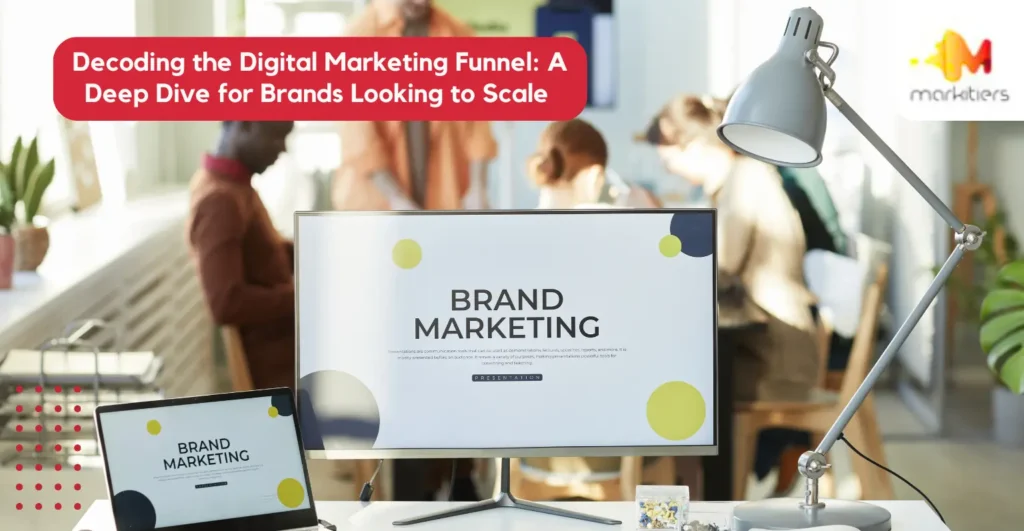In today’s hyper-connected world, it’s rare for a customer’s journey to follow a neat, linear path. Instead, prospects meander through digital marketing strategies, dip into social channels, click on email promos, and often zig-zag between devices. Yet, the digital marketing funnel remains a powerful framework—when eliminated friction and attuned to modern expectations. In this blog, we break down each stage of the funnel and explore how your brand can scale using top-tier online marketing solutions, inspired by the client-centric ethos of Markietiers.
1. Awareness: Light Up the First Spark
Goal: Reach the broadest audience and introduce your brand’s solutions.
This is where content marketing services shine. Publishing blog posts, SEO-optimized pages, and videos helps prospects discover you via search engine optimization (SEO) and social media. Think of this as putting your brand on the map. Aligning messaging with search intent (“best shoes for running,” “how to fix a laptop screen”) boosts visibility.
To maximize awareness:
- Publish evergreen and trend content focused on core terms like “Digital marketing strategies” and “Online marketing solutions.”
- Use paid search and PPC for high-intent keywords (e.g., “best email marketing campaigns” or “top social media marketing tools”).
A blend of organic and paid tactics sets the stage for deeper engagement.
2. Interest & Consideration: Build Trust and Value
Goal: Nurture leads with value-focused content that resonates.
Once awareness is established, potential customers move into the consideration phase. Here, personalized experiences matter. Brands at this stage often deploy:
- Email marketing campaigns featuring case studies or how-tos (“How our content marketing services helped brand X triple leads in 3 months”).
- Webinars demonstrating social media marketing tools or SEO strategies.
- Retargeted ads emphasizing benefits and encouraging return visits.
For example: “Missed our demo of the top influencer marketing platforms? Watch the replay now.” Such touchpoints gently guide prospects toward decisions without hard-sell pressure.
3. Conversion: Make the Buy Easy
Goal: Convert interest into action—sales, sign-ups, trials.
When a lead is ready to decide, reduce friction and ensure a seamless experience:
- Use Pay‑Per‑Click advertising (PPC) with targeted ads and direct CTAs (“Get Instant Marketing Audit”).
- Streamline landing pages—clear copy, minimal fields, strong offers.
- Trigger automated email marketing campaigns to follow up with abandoned carts or demo requests with time-sensitive incentives (e.g., “24-hour 10% off”).
For B2B or larger-ticket items, integrate offers like free consultations with digital marketing consultants to alleviate doubts and clarify ROI.
4. Loyalty: Keep the Momentum Going
Goal: Transform one-time customers into repeat buyers and advocates.
After conversion, your performance doesn’t stop—it evolves. A mature funnel nurtures loyalty:
- Launch email drip campaigns with exclusive content and early access to new products.
- Use affiliate marketing strategies to enable customers to earn by referring their networks.
- Employ influencer marketing platforms to highlight positive experiences, amplifying trust among new prospects.
Loyalty isn’t just about rewards—it’s about ongoing relevance, personalization, and community.
5. Advocacy: Let Your Best Customers Do the Talking
Goal: Ignite brand evangelism through satisfied customers.
A modern funnel recognizes advocacy as its final—and perhaps most powerful—stage:
- Encourage reviews after follow-up emails.
- Launch referral programs through affiliate networks that reward sharing.
- Engage customers in co-created content using influencer marketing platforms to bring their stories to life.
Each advocate becomes both a loyal customer and a brand amplifier.
Modern Funnels: From Linear to Looping
Today’s buyer journeys aren’t straight lines—they’re loops. Customers cycle between discovery and consideration, toggling social, search, email, review sites, and social again before buying—or even between buys. Markietiers-style thinking treats this as a cycle, not a funnel:
- There are always reinvestment points: after purchase, trigger premium content or upsell campaigns.
- Social media marketing tools and content marketing services help maintain relevance throughout this cycle.
- Search engine optimization (SEO) isn’t one-and-done—it continually attracts new audience segments, enriching the funnel’s top.
Final Thoughts
Scaling through the digital marketing funnel means:
- Mastering the full journey—from discovery to advocacy.
- Integrating core channels: SEO, PPC, email, content, social, influencer, and affiliate marketing.
- Tracking consistently, optimizing ruthlessly, looping infinitely.
- Collaborating with expert teams, like digital marketing consultants, who bring both strategic vision and execution firepower.
In a noisy marketplace, it’s not just about the funnel—it’s about the experience across that funnel. Does every email delight? Is every landing page intuitive? Does your brand’s voice carry through each channel? As Markietiers-inspired brands know, the answer needs to be yes.
If you’re ready to refine your funnel and scale with purpose, consider partnering with teams that embody the full spectrum of digital marketing strategies—and guide you, every stage of the way.

